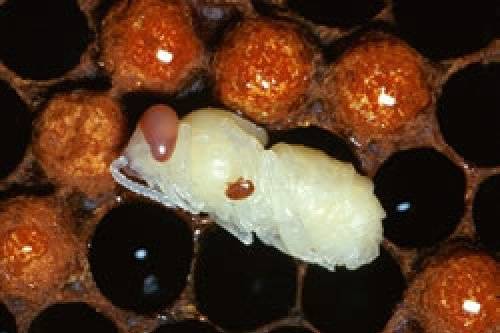The potentially devastating varroa mite, which could wipe out the Australian beekeeping industry, has been detected in Victoria.
A bee colony infested with the varroa mite was detected on Wednesday at the Port of Melbourne on a ship from the United States.
A colony was found in a wooden crate and tests revealed some bees were infested with varroa mite, but the exact variety of the varroa mite is yet to be determined.
Australia is one of the last remaining countries in the world to be free of the blood-sucking varroa destructor, which has already devastated bee colonies in New Zealand, the United States, and Europe.
Varroa destructor is the breed of mite that affects European honey bees, which agriculture industries around the world rely on for pollination.
However, north Queensland has had recent incursions of the less dangerous varroa jacobsoni, which only infects Asian honey bees.
Agriculture Victoria chief health plant officer Nigel Ainsworth said the master of the ship reported seeing dead bees on the ship, which was immediately investigated by Agriculture Victoria and the Commonwealth Department of Agriculture and Water Resources (DAWR) upon docking at the Port of Melbourne.
Mr Ainsworth said the colony had been destroyed and Agriculture Victoria was "confident" the situation was contained to the single colony.
He said three other wooden crates on the ship from Texas had also been secured.
"We haven't had final confirmation as it's a fairly specialised area to formally ID them, but unfortunately we're fairly sure that it's going to be varroa destructor," Mr Ainsworth said.
"[That is] the bad varroa mite, given that it came from the US where that's the form of varroa that is prevalent."
Mr Ainsworth said cold weather conditions meant the bees were lethargic and "pretty unlikely" to have flown beyond the ship.
Laboratory tests of the established sentinel hives at the port returned negative readings for varroa.
As a precaution, more sentinel hives have been installed and floral sweep netting has been undertaken within the port precinct and the adjacent parkland.
Biosecurity officers are also inspecting gardens within a 2-kilometre radius of the port.
"[This is] an example of how the system should work."
Potentially devastating for honey bee industry
Australian Honey Bee Industry Council chairman Lindsay Bourke said the industry was "very concerned" about the detection.
"We are on the lookout for this all the time," Mr Bourke said.
"The only thing in our advantage is that it arrived in Victoria, because Victorians are the most proactive in this department."
Mr Bourke said it was likely the variety was varroa destructor, which is considered more serious than varroa jacobsoni.
He said varroa destructor had been detected in Australia on "a number of occasions".

Varroa mites on honey bee pupae.
(Supplied: Queensland Department of Agriculture, Fisheries and Forestry)
Mr Bourke said New Zealand, which carries varroa destructor, typically posed the biggest threat to Australia.
Varroa impact around the world
It has been reported that hived bees in the United States dropped by about 30 per cent when it was found there, and native bee populations in New Zealand dropped by 90 per cent when it hit NZ.
Last year it was reported that bees in the United States and Europe were starting to evolve through natural selection to survive the mite that was decimating their populations.
At the time, Professor Stephen Martin, chair of animal ecology at Salford University in the United Kingdom, said in some instances bees were living with varroa mites and an associated virus, without any other treatment.
Professor Martin said although the process of evolution was slow, it gave the industry hope and sparked an interest in better beekeeping methods, with people entering the industry to try to save the bees.
He said while the varroa mite sucked the blood of the bee, it was the transmission of a virus into the bee that really caused the damage.
"In areas where there is no virus, the bees and the mites can live together, but this is extremely rare," he said.
"The mite is simply the vector for the virus to get into the bee.
"In Europe and America almost every single bee has got the virus."
By Meagan Rooth





